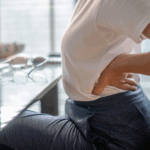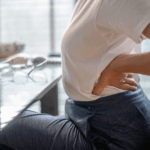
Lower back pain is a chronic condition that affects hundreds of millions of people around the world. A simple exercise could be a big help.
You know the feeling. You bend down to tie your shoelaces and experience a sharp, searing pain in the bottom of your back. Suddenly, you’ve become part of a startling statistic – you’ve joined the estimated 619 million people worldwide living with lower back pain. Luckily, there is a handy exercise which can help, called seated salsa.
And the best thing? You don’t even have to get up to do it.
Lower back pain is the leading cause of disability worldwide. It’s defined as pain between the lower edge of the ribs and the buttocks. It can affect anyone, but is more common in people who are overweight, smoke, or who have a family history of the condition
“I used to work with spinal surgeons, and if you look at where people have most problems in the back, it’s the bottom two discs in the vertebrae,” says Chris McCarthy, an associate professor of physiotherapy at Manchester Metropolitan University.
The backbone is made up of 33 vertebrae, each of which is separated by a spongy layer of cartilage called a disc. The discs provide cushioning; they act as shock absorbers during everyday activities such as walking, running and jumping.

The bottom two vertebrae, where most lower back pain is located, are attached to the pelvis with very thick ligaments. This holds them firmly in place, allowing them to do their job of supporting the weight of the torso. However, there is a downside.
“It’s a really stiff part of the back, and it’s very difficult to get it to move, especially when the local muscles are in spasm due to pain, or tight due to lack of use,” says McCarthy.
One good way to exercise the muscles in the region is to rotate the pelvis from one side to the other, which makes the bottom of the back tilt from side to side in a kind of rocking motion. This happens naturally when you walk. However, when a person experiences lower back pain, the back muscles go into a spasm and immobilise the area, stopping it from moving.
Studies show that, when it comes to back pain, moving is a vital part of the healing process
“Unfortunately, that creates a vicious cycle where it [the lower back] just gets stiffer and stiffer, and more and more painful,” says McCarthy.
Studies show that, when it comes to back pain, moving can be a vital part of the healing process. Usually this can be achieved with exercises, stretches and manual therapy. But most stretches recommended for back pain don’t exercise the bottom part of the back.
That’s where seated salsa comes in. To perform the exercise, sit up straight with your feet firmly planted on the floor. Bring your legs together so that your thighs are running parallel with each other. Then, while keeping your shoulders absolutely still, push your right knee forwards while pulling your left knee back. Then switch so that your left knee goes forward and your right knee goes back. Your pelvis should roll forwards on one side and back on the other side, just like in a traditional salsa dance. Repeat this movement for one minute.

“Your pelvis is doing this little sort of rocking motion, which is what it’s supposed to do when you’re walking,” says McCarthy.
McCarthy and colleagues at the MMU Manchester Movement Unit, a physiotherapy unit, have conducted a yet-to-be-published pilot study, where they asked patients with lower back pain to perform the seated salsa while hooked up to electromyography (EMG) sensors. The sensors measure how tight the muscles are in the back. The results showed that just one minute of seated salsa every 30 minutes was enough to make their muscles relax, easing symptoms of back pain.
“The nice thing about it is it’s very easy to do whilst you’re at work. You don’t even have to get up from the desk,” says McCarthy.
The exercise could also be useful for older people who maybe can’t stand up and sit down as easily
Office workers often spend large portions of the day sitting down, raising the risk of lower back pain. Standing up more and walking around – even if it’s just to get a drink – can help reduce this risk. However, sometimes getting up from a desk is not feasible.
“If office workers are in the middle of something and they don’t want to get up and stretch, rather than standing up, you could just every half an hour, have a little bit of seated salsa for a minute or so,” says McCarthy.
The exercise could also be useful for older people who maybe can’t stand up and sit down as easily, or for people who have reduced mobility after an operation. Research shows that keeping mobile and exercising regularly is key to living a long and healthy life.
“We know that lots of older people are not very physically active,” says Jugdeep Dhesi, a consultant geriatrician and president of the British Geriatrics Society.
“If you are not able to move properly, seated exercises are a good way of building up strength. But if you are, then there’s so much stuff people could do. Whether it’s standing on one leg while you’re brushing your teeth, or doing just two or three squats holding the back of the chair while the kettle is boiling – it’s all about building this into a habit that just becomes a norm that you will always do.”
- President Commissions 36.5 Million Dollars Hospital In The Tain District
- You Will Not Go Free For Killing An Hard Working MP – Akufo-Addo To MP’s Killer
- I Will Lead You To Victory – Ato Forson Assures NDC Supporters
Visit Our Social Media for More




